loden boy bisschop token
"De geschiedenis van Sint-Nicolaas.. In een van de bekendste verhalen redt
Nicolaas drie arme meisjes van de prostitutie door anoniem drie beurzen met geld naar
binnen te gooien. Zo kunnen ze toch een eerzaam huwelijk sluiten. Op basis van dit verhaal
werd Sinterklaas ook gezien als beschermheilige voor jongeren die een goed huwelijk
zoeken. Dit leidde later weer tot de zogenaamde ‘vrijers’ van taai-taai. De
beurzen met geld echoën na in de hedendaagse chocolademunten.
Een verklaring voor het strooien dat gebruikelijk is tijdens Sinterklaas, is dat de
strooiende beweging symbool staat voor de boer die zijn akker zaait. Strooien staat voor
vruchtbaarheid en daarom wordt er op bruiloften ook rijst of confetti gestrooid de
traditie van chocolademunten rond Sinterklaas komt voort uit de legende waarin Nicolaas
hoorde van een arme vader die zijn dochters geen bruidschat mee kon geven, waardoor de
vrouwen zich moesten prostitueren. Nicolaas wachtte tot het donker was en gooide een
buidel met geld het huis in, waardoor de oudste dochter kon trouwen.
In een andere legende kalmeerde de heilige een woedende zee. Dit vormt de bron van zijn
patronaat van zeelieden en schipbreukelingen en verklaart waarom vele Nicolaaskerken en
kapellen aan zee gelegen zijn. Het verklaart ook waarom hij bij Nederlandse intochten per
schip aankomt.
Van later datum is het verhaal over een miraculeuze redding van drie geslachte en
ingezouten scholieren, waarmee Sint-Nicolaas beschermheilige werd van scholieren.
Rond 1200 was zijn verering vrij algemeen onder scholieren, huwbare jongeren,
zeelieden, reizigers en kooplieden. Er werden tal van Nicolaaskerken gesticht en veel
jongens werden naar hem vernoemd. Als onderdeel van die verering werd zijn sterfdag
gevierd, op 6 december. Vaak werd een sterf- of naamdag gevierd vanaf de avond eraan
voorafgaand. Zo werd 5 december sinterklaasavond. Met name scholieren vierden het
Sint-Nicolaasfeest. Soms kregen ze een dag vrij en geld.
Maar in de Middeleeuwen vonden méér feesten plaats in december. In het
kloosteronderwijs ontstond in de dagen na kerstmis de traditie van ‘de omgekeerde
wereld’, waarin kinderen voorrechten kregen die ze anders niet hadden. Een jongen
werd gekozen tot jongensbisschop en de kinderen werden getrakteerd. Dit groeide uit tot
het feest van de Onnozele (= onschuldige) Kinderen, dat gevierd werd op 28 december.
In de dertiende en veertiende eeuw ging de verkiezing van kinderbisschop samenvallen
met de jaarlijkse Nicolaasfeestdag op 6 december, dat zo versmolt met onnozele
kinderendag. Het feest had typisch christelijk-middeleeuwse elementen, zoals de
wonderbaarlijke verschijning, de combinatie van straffen en belonen, en het toetsen van
kennis van de bijbel." bron http://www.kennislink.nl/publicaties/de-geschiedenis-van-sint-nicolaas
Het concilie van Osford in 1222 heeft 6 december bepaalt als naamdag van Sint Nicolaas.
Congaudent(es) Exsultemus is de elfde-eeuwse publicatie waarin de legende van Sint
Nicolaas verteld wordt.
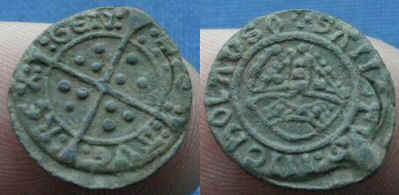 |
kz. kruis met drie bolletjes tussen de benen, ave rex gen tis
vz. bisschopsmijter, sanctus nicholasMitchiner 8? Bury Saint Edmunds?
1,49 gram, 15,37 mm, 16,70 mm
The Celator, 12 dec. 2005
GBP 26,31 ( EUR 47,06), 09-sep-07, ebay, sjblencoe |
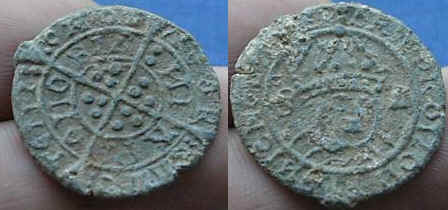 |
Groot, vz: lang kruis, met drie bolletjes, legenda wellicht: Ecce Nova
Facio Omnia/ Ave Rex Gentis
kz: buste van Sint Nicolaas tussen S N (Sancte Nichola) legenda wellicht Sancte
Nicholai Ora Pro Nobis (Saint Nicholae pray for us)
Offered is this lovely and very interesting Medieval Lead Boy Bishop Token. These were
minted for the feast of fools in which status was reversed and poverty stricken were
waited upon and treated like royalty. It is in much better condition that most I have seen
and the flan is not cracked at all. It is a beautiful and interesting piece of history,
4,00 gram, 22,57 mm, 23,33 mm
GBP 26,55 (EUR 33,53), 17-aug-08, ebay, sjblencoe |
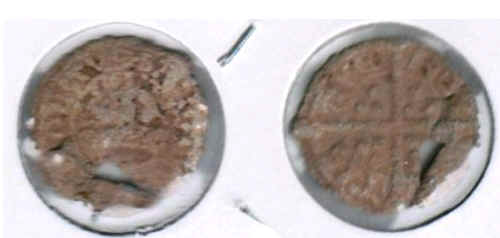 |
Authentic Lead Boy Bishop commemorative token, 1399-1547
OBV: bishop's mitre, SANCTVS.NICHOLAVS REV: cross, 3 pellets in antlers, AVE.REX.GENTIS
From the Abbey of Bury St. Edmunds
1,47 gram, 16,34 mm, 16,60 mm
ebay, 19 okt. 2011, US $10,00 (EUR 7,51), roaming_cavalier |
| |
|
Santa Claus as Depicted on Obsolete Bank Notes, sold by Heritage Currency
By Kathy Lawrence
Many countries have versions of St. Nicholas. The American version came to us by means of
the early Dutch settlers in New York (then known as New Amsterdam). That version of Santa
Claus was a much thinner man than what we're accustomed to today. The poem, "The
Night Before Christmas," (originally published as "A Visit From St.
Nicholas") by Clement Clarke Moore in 1823 forever altered our view of the man and
led to an increased popularity of Santa. Moore wrote the Christmas poem for his children,
but it was later widely published along with a representation of Santa that was painted by
newspaper artist Thomas Nast in 1870 based on Moore's poem.
A number of Northern states designated Christmas as a state holiday in the mid 1800s.
Since banks often chose vignettes that would lead customers to have faith in the bank, it
is not surprising that Santa Claus vignettes were chosen by some banks to help acquire
confidence and goodwill. The banks may have also hoped that customers would set a lower
denomination note aside as a keepsake due to the Santa vignette as well. The vignettes
found in this collection portray both the thinner Dutch version of Sinterklaas as well as
the more Americanized version.
Heritage Currency is pleased to present The
Roger H. Durand Santa Claus Notes Collection as part of our FUN
Signature Currency Auction being held in Orlando from January 5 thru 8. Given the fact
that most of the notes with Santa Claus vignettes are scarce to extremely rare, this is
indeed a fabulous and noteworthy collection. Roger's initial purchase that began this
collection took place in 1960 at a cost of $17 — several multiples of what most
Obsoletes cost at that time. At that time, there was only one reference on the subject
— a five page monograph by John A. Muscalus, Ph.D. published in 1959. That work was
followed in 1973 by a publication from Larry L. Ruehlen that ignited the interest of
collectors.
There were far fewer notes than there was demand for and the notes are generally prized
and closely held, so building a collection was quite the challenge. Although that is still
the case, the sale of the American Bank Note Company archives in 1990 did add more
material to the marketplace along with Part VI of the Ford sale in October 2004, although
the Ford sale consisted primarily of material he purchased at the 1990 sale. The continued
interest in the Santa Claus vignettes is evidenced by the fact they took the number 23
spot on the list of The 100 Greatest American Currency Notes list, and the recent auction
sale of a circulated Santa Claus note for over $40,000, an amazing price indeed for any
obsolete banknote.
Below some notes from this sale
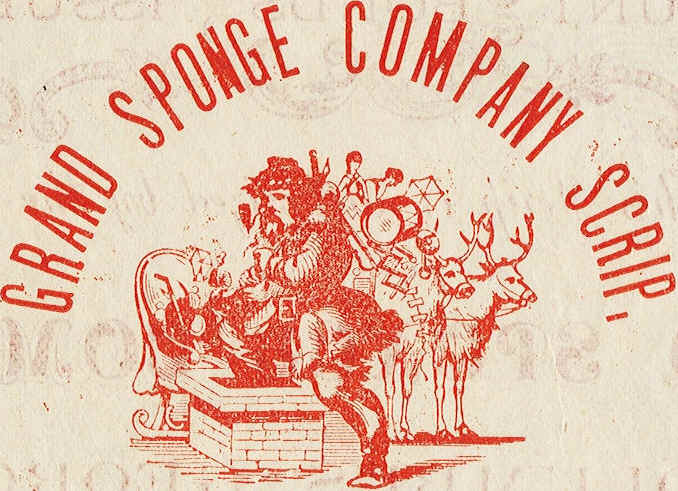 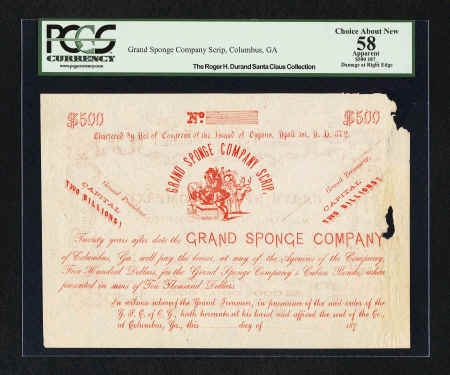
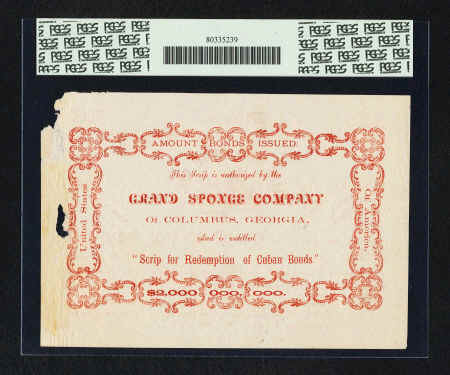
|
Columbus, GA- Grand Sponge Company Scrip $500 (1870s) This is the only
known example of this unsigned, over-size bond measuring approximately 5 ¼ x 7 ¾ inches
and printed in red ink. There is no imprint. The piece was "Scrip for Redemption of
Cuban Bonds" as per the text. It purports that the company was chartered by an Act of
Congress of the Island of Cyprus on April 1st, A.D. 572 and listed capital of "TWO
BILLIONS!." The Grand Sponge Company remains an enigma as of this writing as no
information has been uncovered, however it is believed that it served as a front for
racketeers. Santa is portrayed stepping into a chimney with his sleigh and reindeer in the
background at the center of the note. As with the other notes contained in this offering,
this item is the plate note in Roger Durand's book, The Fabulous Roger H. Durand Santa
Claus Notes Collection: And a Complete Report of all Santa Claus Notes, and is pictured on
pages 77 and 79. This particular vignette is not included in Durand's listing of the seven
types of Santa Claus vignettes and is believed to be unique. PCGS Apparent Choice About
New 58, with the apparent grade assigned due to the damage seen at right. An irreplaceable
item worthy of serious bidding. From The Roger H. Durand Santa Claus Collection Jan 5,
2012, lot 15689, euro 1400 Columbus, GA- Grand Sponge Company Scrip $500 (1870s). ... 2012
January Signature FUN Currency Auction #3516, |
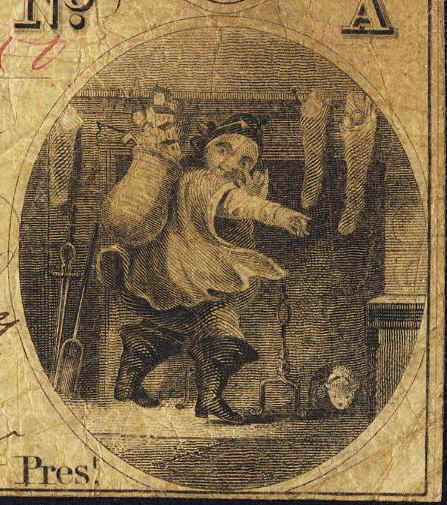 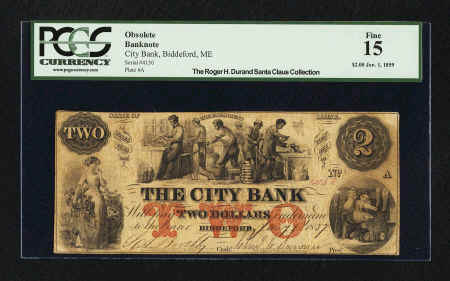
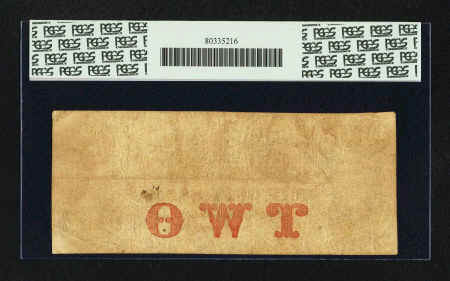
|
Unique Santa Claus Vignetted $2 City Bank of Biddeford Note Biddeford, ME-
City Bank $2 Jan. 1, 1859 G4 Wait 16 The City Bank was incorporated in 1856. In 1865 it
became the First National Bank of Biddeford, charter number 1089. All of the notes from
this bank are listed in the Wait reference with a rarity rating of R.7, indicating one to
five known examples. In the case of this $2, it is the only known example. The note
includes an oval vignette of Santa Claus at lower right, the style that Durand has
identified as Santa Type II. The note's central vignette depicts workers in action at a
shoe factory. Perhaps Santa was delivering their products. A red "TWO" overprint
is seen on this note graded Fine 15 by PCGS that includes the imprints of both Rawdon,
Wright, Hatch & Edson and the New England Bank Note Co. It is believed that Freeman
Rawdon, George W. Hatch, or James P. Major performed the engraving work. The note is
problem free, with even circulation, clear signatures, and excellent eye appeal for the
grade. From The Roger H. Durand Santa Claus Collection Estimate: $20,000 - $30,000. jan
5 2012, euro 15.700, 15690 Biddeford, ME- City Bank $2 Jan. 1, 1859 G4 Wait 16. ... 2012
January Signature FUN Currency Auction #3516 |
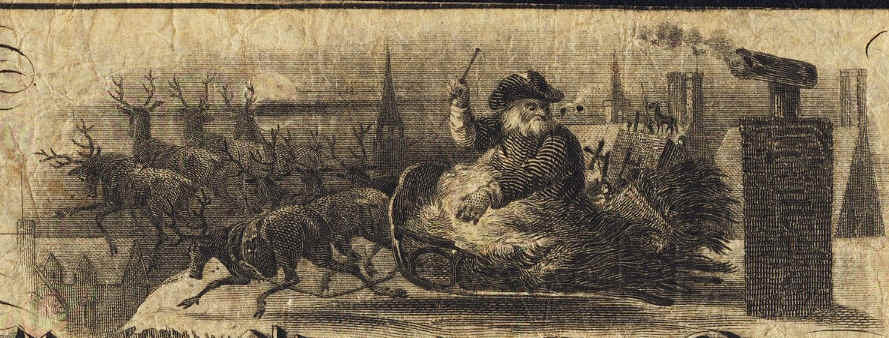 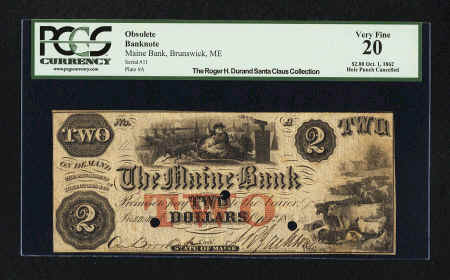
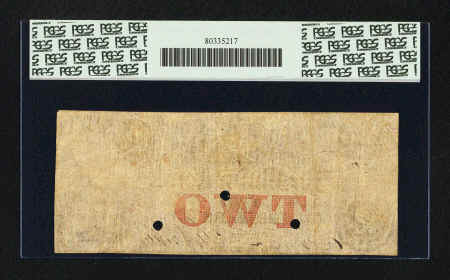
|
Brunswick, ME- Maine Bank $2 Oct. 1, 1862 G4a Wait 19 The Santa Type I
vignette is seen at top center on this scarce note, also listed as R.7 in Wait. Durand
believes there are approximately ten surviving examples. The well printed and well signed
note received a grade of PCGS Very Fine 20, 3 POCs. Fortunately for collectors, the POC's
are nowhere near the lovely Santa vignette at the top center of the note. This example
carries the same two imprints as the note above. The three possible engravers listed above
are the likely candidates for the engraving of the Santa Claus vignette on this $2 as
well. The Maine Bank was incorporated in 1857. It became the First National Bank of
Brunswick, charter number 192, in 1864. jan 5 2012, euro 6550, 15691 Brunswick, ME-
Maine Bank $2 Oct. 1, 1862 G4a Wait 19. ... 2012 January Signature FUN Currency Auction
#3516 |
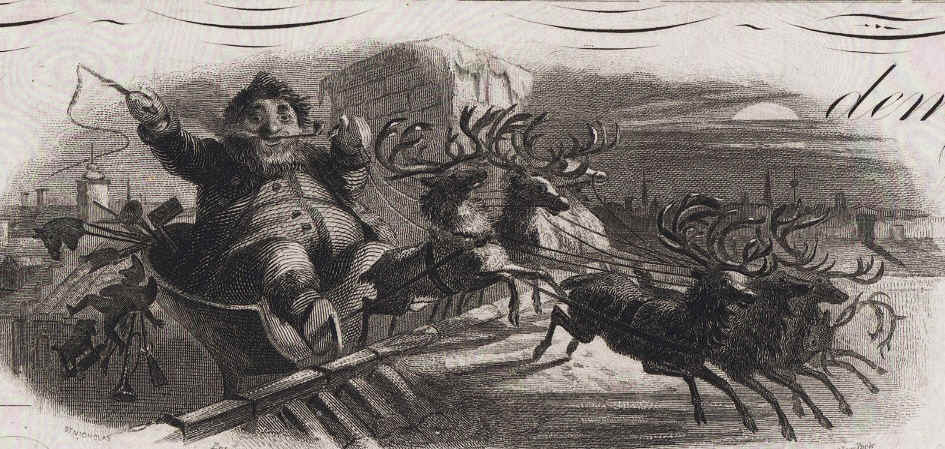 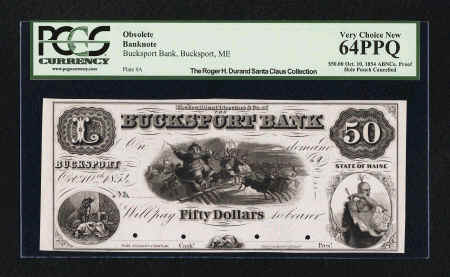
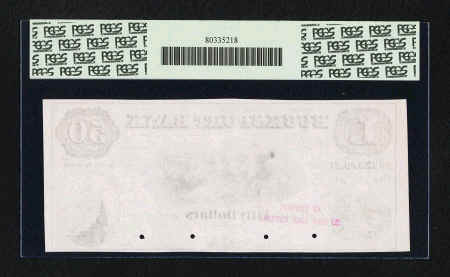
|
Bucksport, ME- Bucksport Bank $50 Oct. 10, 1854 G16a Proof Wait 11 A well
preserved Proof from the American Bank Note Company archives graded Very Choice New 64PPQ
by PCGS. Four small POCs are observed at the signature lines. Prior to the sale of the
American Bank Note Company archives in 1990, these notes were all but unknown and have
only been reported in Proof form, with just over a dozen known survivors according to
Roger Durand's research. Wait listed these notes as R.7. The central Santa Claus vignette
contains an example of the design identified as Santa Type III. George D. Baldwin was the
engraver. He is known as the engraver of the Ocean Telegraph vignette that was used for
$20 Gold Certificates, the Eagle with Flag vignette used on the backs of the $500 Gold
Certificates, and General Winfield Scott's portrait that was used for $100 Interest
Bearing Notes. There are two imprints- Bald, Adams & Co. New York and Bald, Cousland
& Co. Phila. The Bucksport Bank was incorporated in 1854 and became the Bucksport
National Bank, charter number 1079, in 1865. jan 5 2012, euro 3700, 15692 Bucksport, ME-
Bucksport Bank $50 Oct. 10, 1854 G16a Proof Wait 11. ... 2012 January Signature FUN
Currency Auction #3516 |
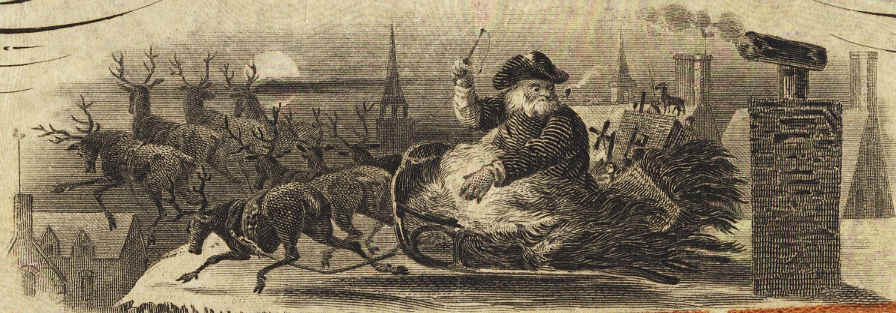 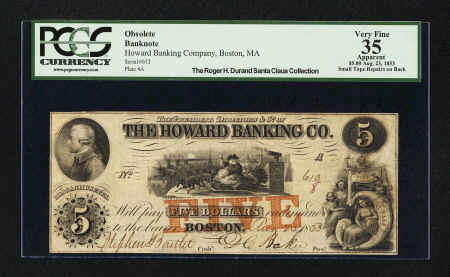
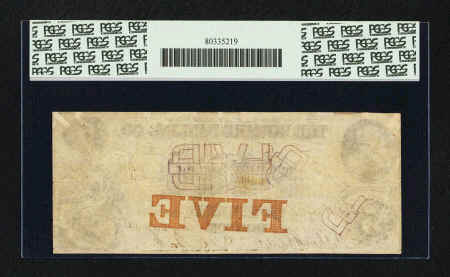
|
Boston, MA- Howard Banking Company $5 Aug. 23, 1853 G8a Although quite
similar in appearance to the notes identified as counterfeits below, the eye in the
portrait of John Howard at upper left on this example displays the work of a more skilled
engraving hand. Howard (1726-90) was an English prison reformer who authored State of
Prisons in England and Wales in 1777 as mentioned by Durand on page 66 of his Interesting
Notes About Portraits reference. Two "PAID" rubber stamped notations from Howard
National Bank, the bank's third incarnation, are observed on the back. This is one of only
two genuine notes known, however this is the only example that was redeemed by the bank.
PCGS Apparent Very Fine 35 with small tape repairs on the back cited as the reason for the
apparent grade. The tape repairs are minor and are of little importance on a note of this
rarity. jan 5 2012, euro6550, 15694 Boston, MA- Howard Banking Company $5 Aug. 23, 1853
G8a. ... 2012 January Signature FUN Currency Auction #3516 |
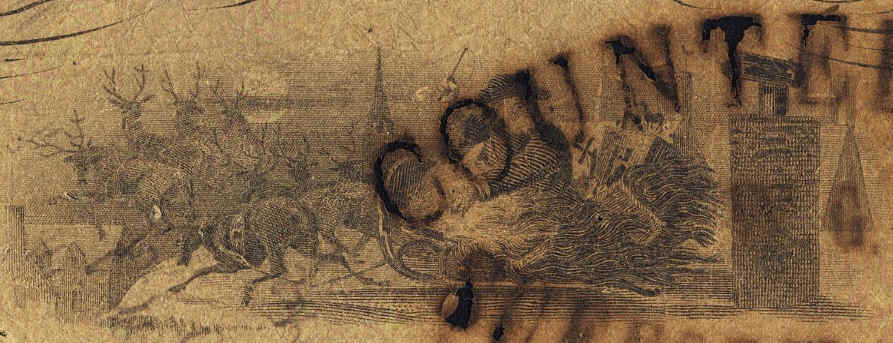 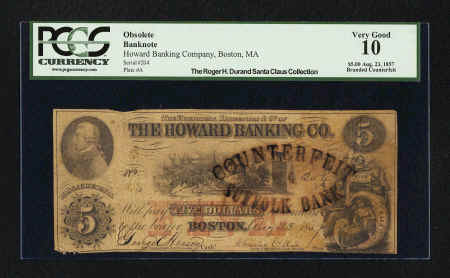
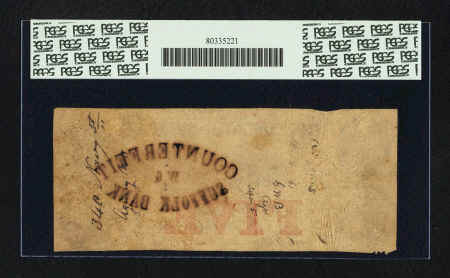
|
Boston, MA- Howard Banking Company $5 Aug. 23, 1853 C8a Counterfeit An
oval "COUNTERFEIT SUFFOLK BANK" rubber stamped notation is seen on the face of
this note. As is often the case with those stamps, areas of ink erosion are noticed. The
Suffolk Bank in Boston, open from 1825-58, served as a clearing house in New England and
earned them considerable profits. It was the first of the region-wide bank note clearing
systems and allowed notes to circulate at par, rather than at a discount as was often the
case when a note circulated beyond the area it was issued from. In addition to counting
and sorting money from various country banks, they also performed counterfeit detection
and marked those bills that they declared to be counterfeits or altered notes. The
directors of the Suffolk Bank were considered quite patriotic as they advanced
considerable funds to assist the war effort during the early days of the Civil War. PCGS
Very Good 10, with the Type 1 Santa vignette at the top center of the note. jan 5 2012,
euro 395, 15696 Boston, MA- Howard Banking Company $5 Aug. 23, 1853 C8a Counterfeit. ...
2012 January Signature FUN Currency Auction #3516 |
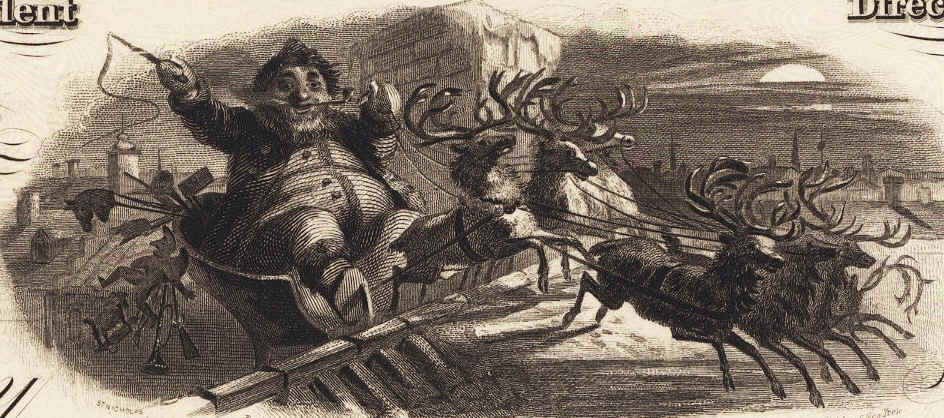 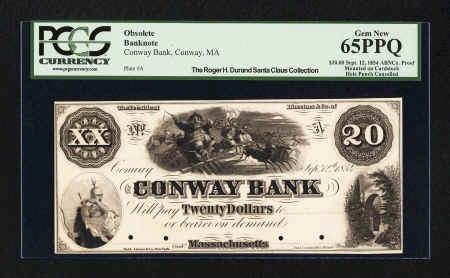
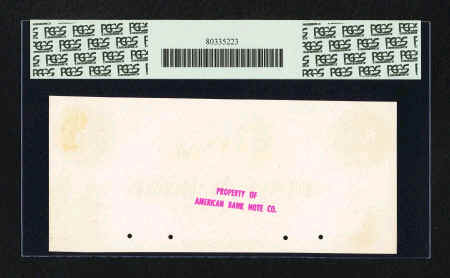
|
Conway, MA- Conway Bank $20 Sep. 12, 1854 Haxby UNL Proof This rare
example shares the same Santa Type III vignette and Native American warrior design as the
Bucksport note above along with the Bald, Adams & Co. New York and Bald, Cousland
& Co. Phila. imprints. As with that note, examples from this bank have only been
reported in Proof form, with nine notes known from this bank. This ABNCo Proof is mounted
on cardstock and has four small POCs at the signature lines. There is no overprint on this
example graded PCGS Gem New 65PPQ, making it an unlisted variety. This bank was a
contemporary of the other banks listed above, having been in business from 1854 to 1864
and then becoming the Conway National Bank, charter number 895. The bank was incorporated
with $100,000 capital stock. Copper and steel printing plates along with several Proofs
without the Santa Claus vignette are included in the Obsoletes portion of the auction. In
addition, a copper printing plate for checks from the bank's National Bank days is
included within the Nationals section. jan 5 2012, euro 4800, 15697 Conway, MA- Conway
Bank $20 Sep. 12, 1854 Haxby UNL Proof. ... 2012 January Signature FUN Currency Auction
#3516 |
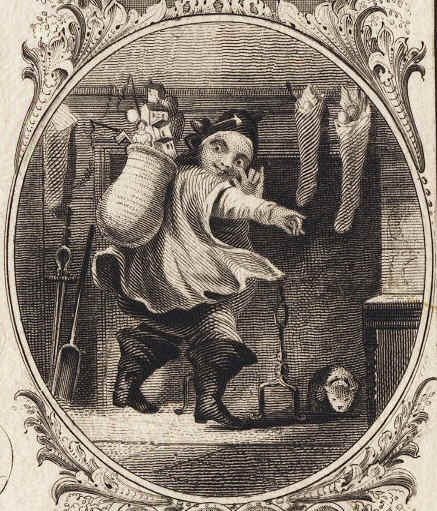 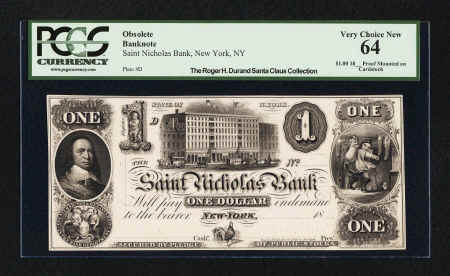
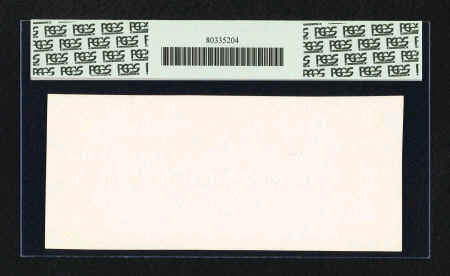
|
New York, NY- Saint Nicholas Bank $1 G2 Proof A bank with a great name,
the Saint Nicholas Bank was in business under this title from 1852 until 1865 when it
became the Saint Nicholas National Bank of New York, charter number 972. The bank was
liquidated on Dec. 30, 1882. There were a number of different businesses in New York at
the time that used the Saint Nicholas name, including an insurance company. The Saint
Nicholas Bank had one issue of bills and all save the $100 denomination included a Santa
Claus vignette. This is one of only two $1 Proofs known without a red protector. The other
example resides in the American Numismatic Association's collection. Santa Type II, a
young and clean-shaven depiction of Santa, is seen in the oval frame at right. The note
was the product of Rawdon, Wright, Hatch & Edson, New York. It is believed that the
engraver was Freeman Rawdon, George W. Hatch, or James P. Major. The portrait at left
represents Peter Stuyvesant (1592-1672), an important figure in New York history. The
portrait and a biography of Stuyvesant appear on page 122 of the first volume of Durand's
Interesting Notes About Portraits reference. The cardstock and depth of impression vary on
this example along with the $3 Proof from this bank offered below. It has been theorized
that perhaps these pieces were special commemorative proofs that were bestowed by the
National Bank's officers to their clients. This unique in private hands Proof, mounted on
cardstock, earned a grade of Very Choice New 64 from PCGS and was Lot 756 in the 2004 Ford
sale where it sold for $4887.50 with the buyer's fee. Expect a considerably higher
realization by the time bidding ends this evening. jan 5 2012, euro 4370, 15706 New
York, NY- Saint Nicholas Bank $1 G2 Proof. ... 2012 January Signature FUN Currency Auction
#3516 |
 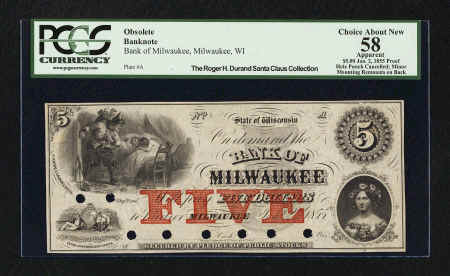
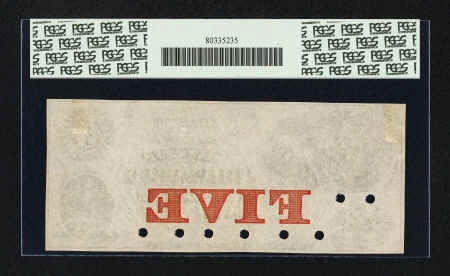
|
Milwaukee, WI- Bank of Milwaukee $5 Jan. 2, 1855 G6d Proof Krause G6d
There are a number of varieties of these notes. This Proof includes the red FIVE
overprint, the TC imprint and ABNCo. monogram, and capital listed in the amount of
$300,000. The Santa Type IV is found on these notes and these notes only as mentioned in
Durand's article, "Jolly Old St. Nick on Notes" on page 27 of the December 2009
issue of The Numismatist. This is one of only two reported examples with the red FIVE
protector, with one example known lacking the red overprint. The three examples make up
the entire census of Type IV Santa notes. The Durand collection is one of only two to have
a complete set of Santa notes by type (excluding the unknown Type VII, which may or may
not exist). The second set is owned by a well known Florida couple long active in
numismatics. The vignette features Santa on the verge of leaving a doll for two girls
sleeping in a nearby bed. Eight POCs are noticed on this example graded Apparent Choice
About New 58 by PCGS with minor mounting remnants on the back listed as the reason for the
apparent grade. The mounting remnants are truly trivial, and the note is a lovely piece
with a vividly colored protector and stunning eye appeal. These notes were issues of the
second incarnation of the Bank of Milwaukee, in business from 1855 until April 1865, when
it then became the National Exchange Bank of Milwaukee, charter number 1003. jan 5 2012,
euro 17500, 15723 Milwaukee, WI- Bank of Milwaukee $5 Jan. 2, 1855 G6d Proof Krause G6d.
... 2012 January Signature FUN Currency Auction #3516 |





























